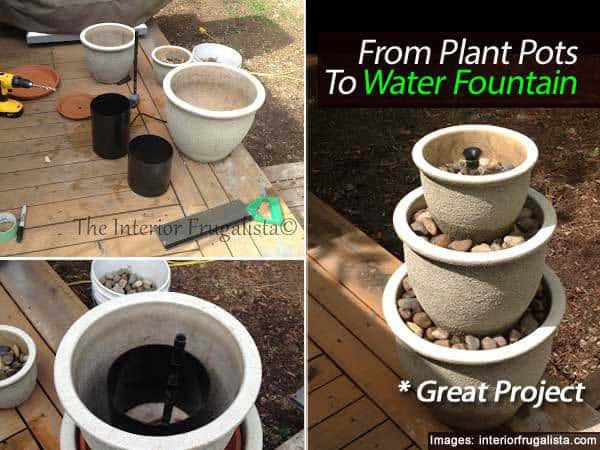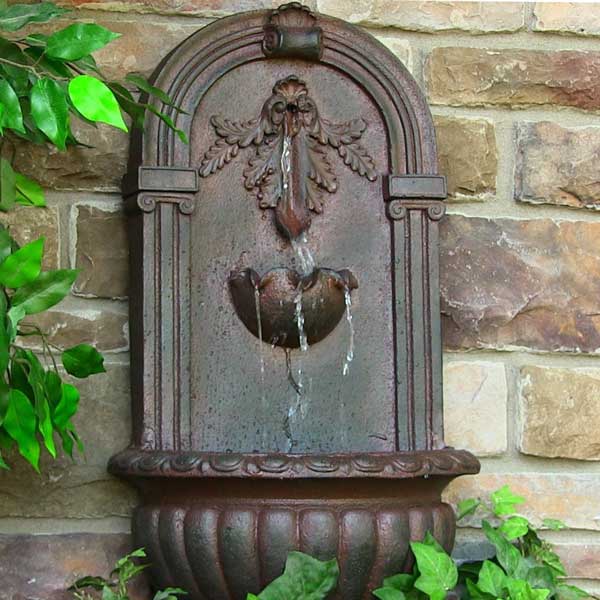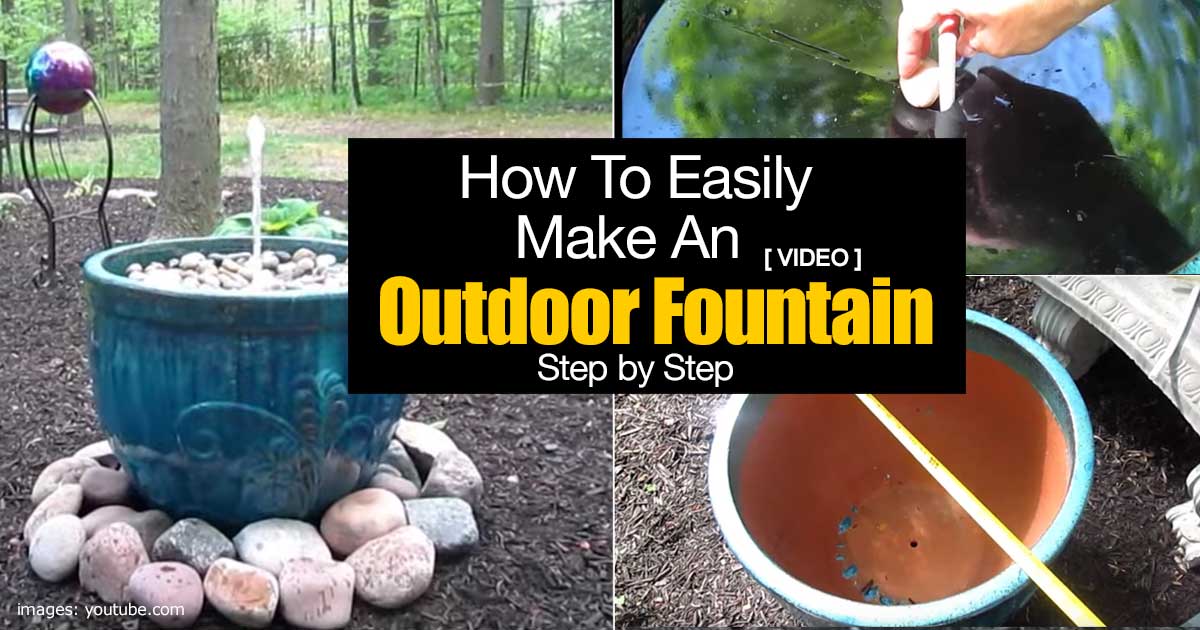There’s nothing more tranquil, striking and that makes a powerful statement in the landscape like a garden water fountain.
However, since not all outdoor water fountains can suit your garden landscape, it’s important to consider a few items about outdoor fountains before making the purchasing decision.

Here are some tips to help you before adding this water feature to your patio, deck, or garden.
- What Are Some Of The Different Types of Outdoor Garden Fountains?
- What Kind of Pumps Are Used in Garden Water Fountains?
- What Types Of Garden Water Feature Styles To Consider For Your Garden?
- Where Should A Garden Water Fountain Be Placed?
- Why Add A Water Fountain To Your Garden?
- Fountain Safety Tips
- How to Build an Outdoor Zen Garden Water Fountain?
- Summary
What Are Some Of The Different Types of Outdoor Garden Fountains?
There are different types of water fountain gardens, each unique to suit the landscape settings. Also, the purpose of the fountain will also help determine the fountain type to add to the garden.
For example, a formal garden may require a classic standing outdoor patio fountain which may have a contemporary or traditional look.
A naturalistic garden may be a small pool or pond fountain fitted with softy dancing water jets or a disappearing fountain.
Animal lovers can build their own animal statues and convert them to a fountain. On the other hand, those who like aquatic creatures can make fish or dolphin fountains.
Besides a straight jet, you can also fit it with nozzles that squirt water in various shapes such as mushroom, daisy, or tulips forms.
The outdoor fountain could also be simply a wall-mounted waterfall unit with a spout into a reservoir.
In all these cases, a pump is required to keep water recirculating. Home improvement stores and garden centers sell kits containing all the equipment required, including the nozzle, fountainhead, pump, and power cord.
What Kind of Pumps Are Used in Garden Water Fountains?
There are two types of pumps found in home water fountains; Submersible pumps and surface pumps.
Submersible pumps are made for safe, quiet operation underwater. Surface pumps sit aboveground and must be concealed.
Choose a pump slightly larger than needed so you’ll have more leeway to adjust the water flow.
Submersible Pumps
Submersible pumps are designed to be placed in the deepest part of the pond. They are safe and easy to install. They are ideal for environments that have a natural setting.
Surface Or External Pumps
Surface or external pumps are installed aboveground and must be camouflaged. They can be loud and works well for larger ponds, much like a pool pump.
When choosing a pump, it’s advisable to choose one that is slightly larger than needed so that you can have room for adjustment.
Caution: Plug an electrical pump into the ground-fault circuit interrupter to shut down power when there are problems or danger.
What Types Of Garden Water Feature Styles To Consider For Your Garden?
Tabletop Fountains
Tabletop fountains are great for small patios and garden rooms. They take up moderately small space and add an element of intricacy and sophistication to your patio or garden.
They are affordable (you can easily make your own tabletop fountain with terra cotta pots) and are preferred by people on a tight budget. They are safer for pets and kids. Tabletops fountains make great gifts for friends, family, and friends.
Water Fountains Made From Rock
Garden fountains made from rock are long-lasting and enjoyed for several decades or even generations depending on the weather, maintenance, and the type of rock used. Some of the common types of rocks include:
Limestone – it’s an opaque natural rock. It was a popular material in Egypt and Middle-East as it was used to make the Great Pyramids. However, it’s not as popular material nowadays as items made from it erode after several years.
Granite – if you’re looking for an outdoor fountain that can last for generations, then granite can make an ideal material for you.
It can withstand freezing temperatures and will not crack during winter. It’s also easy to clean using liquid. Also, it’s not susceptible to wearing away.
Cast Stone – Cast stone makes fountains that have reasonable durability and most of the time, have the highest quality. Fountains made of cast stone can last for several decades. Pumps may need to be replaced over time.
Related Reading: Making and Outdoor Fountain
Pool Or Pond Fountains
This type of fountain stirs the water, thereby creating an unfavorable environment for the breeding of mosquitoes. The fountain also increases water circulation, which improves water quality.
This improves the quality of fish and plants and also inhibits the growth of algae. A larger container water garden fountains are ideal for those who want to create eye-popping visual effects in their garden.
If you want a fountain to be the focal point in your garden decor and you have space, a pool or pond fountain makes an ideal choice for you.
Check out bluworld of water for some interesting garden fountains.
Outdoor Wall Style Fountains
Outdoor wall fountains like this one above from are an ideal choice for those who want a calming effect and a feature that captivates visitors. They’re great when space is limited.
They have an easy installation process and are also pet accessible; pets prefer drinking from a fountain. They can be used in vertical spaces that want to be covered; these fountains can cover the vertical area from the floor to the ceiling.
Floor Style Water Fountains
They are quite similar to the wall style fountains, with their major difference being that they cover the horizontal space or floor. This type of outdoor water feature looks great especially with awesome lights installed.
They too, are easy to set up and are also easily moveable as they aren’t fixed to a wall.
Pyramid Style Fountains with Tiers
These types of fountains take a shape of a pyramid with several levels of water dripping from them. Most pyramid-style fountains with tiers have two or three tiers. They’re ideal for those who want a calming effect.
Urn Style Garden Fountains
These garden water fountains have an urn situated inside a bowl or vessel. They are ideal for garden and outdoor settings as they create a striking statement.
These fountains usually what are referred to as “pondless”, are easy to make and often have a “bubbler” where the water gently cascades over the edge of the pot.
Fountains Made From Pots
These types of fountains are made in a way that one pot spills water to the other. Most of them have three pots positioned in a stylish, unique way.

The design is customizable, it can be made with pots you already have, large or small to fit any space you have. You can decorate it the way you like after.
NOTE: All the above fountain types can be used as feng shui water fountains. However, for them to be used as a feng shui “cure”, they do not have to look oriental.
Fountains are very popular in feng shui as they’re known to bring water energy and are also a symbol of prosperity and wealth.
However, when looking for the ideal feng shui fountain placement keep in mind not to place it in your bedroom as the water shui elements create the energy of sorrow and worry in the bedroom.
Where Should A Garden Water Fountain Be Placed?
A free-standing or pool fountain should be placed in a prominent area where it can act as a focal point. For example, you can place this lawn ornament at the intersection of two paths or at the center of the small terrace.
A wall fountain is not very conspicuous and carries much more impact when it is the element of surprise. Placed a wall fountain at the side of the garden or at the end of a pathway to spark surprises.
Why Add A Water Fountain To Your Garden?
Fountains Can Be Simple and Soothing
Build your own small Japanese-style fountain in a quiet corner of the lawn and garden. Submerge a small pump in a stone bowl and use a hidden pipeline to connect it to a hollow bamboo pole.
Add a second bamboo cane that will fill with water and tip down to trickle its contents gently into the basin. Adjust the pump so that it issues a light trickle.
Fountains Help Cool the Garden Air
Fountains can have a cooling effect on plants and people, especially in arid climates. Also, the splashing sound of water features seems refreshing during a hot day.
Fountains Provide “White Noise”
Fountains can be used to block disturbing noise from roads or neighbors. The persistent trickle of water has a calming background effect.
Fountains Attract Wildlife – Birds and Butterflies To The Garden
Birds can be attracted to fountains, especially those with ample space for birdbaths. This adds to the beauty and natural serene of your garden.
Fountain Safety Tips
Keep Your Fountain Kids Safe!
When installing a fountain, keep the safety of your kids and pets in mind. Fountains should be placed in a raised area that’s inaccessible to most people, especially toddlers.
Don’t forget… some pets and kids may even try to use the pond for drinking water.
For pool fountains, place a grill over the top of the pool, leaving a small opening for the pipe. You can raise the sides of the pool with pretty stones to make it safer.
Do Not Disturb The Aquatic Plants
You can add water lilies and other aquatic plants around your fountain to prevent people from going near it. However, keep them away from the submersible pump.
How to Build an Outdoor Zen Garden Water Fountain?
Add serenity to any setting with the soothing sounds of a fountain you made yourself!
What you’ll learn in the video:
Every basic fountain comes with a base, a ball, and a fountain pump. The pillar base and the ball are usually made from concrete.
To form the pillar of the concrete fountain, you will need a Quiktube form on your work surface. Inside it, place a bucket upside down and lodge a piece of PVC right into the center.
The bucket should stay upside down at the center. Also, the PVC should remain centered while filling out the form. The bucket will create a void at the bottom of the pillar to house the pump for the fountain and the PVC will provide a path to feed the tubing up for the fountain.
Use a light fixture globe for the form of the ball. Spray the inside with cooking spray so you get a clean release and fill the globe all the way up to the base. This gives the ball a flat surface so it will sit nicely on the pillar.
Just like what you did with the pillar, you need to create a path through the ball. Use another piece of the PVC with the end taped off. Push it all the way down into the other end of the globe and use some tape to hold it in place. This works a lot easier than trying to drill through the ball later.
Wait until the base and the ball cement dry out. Once they dry, you can release them from their forms. You can just tear or cut away the casing on the pillar, but you need to carefully break the globe.
Wrap the ball in some heavy-duty plastic, wear gloves and eye protection, and then tap the globe so it shatters into the plastic for safe and quick cleanup. Use a flexible multi-saw like this to trim away the excess PVC on both pieces.
The last phase of this process involves tearing out the other end of these parts. Use a dowel so you can pull away any extra tapes. Now, you can start assembling the fountain.
Prep a hole and place a pan in it so the lip becomes flushed with the ground. Put a layer of river rock in the pan. Place the water pump and then surround it with more rock.
With the pillar on its side, feed the tubing up through the PVC. Then tip the pillar into place over the pump. Next, feed the tubing up through the ball so you can gauge the length before you trim it back.
The tubing needs to come all the way to the top of the ball. Seal this with a little silicone and add your ball.
Once it dries, finish filling in with rocks, fill the pan with water, and turn on the fountain source.
For more detailed directions and outdoor projects, go to Lowes.com.
Summary
Adding a water fountain to your garden is an attractive feature that you should consider including in your landscape design. It complements the beauty of your garden and adds a serene setting to it.


